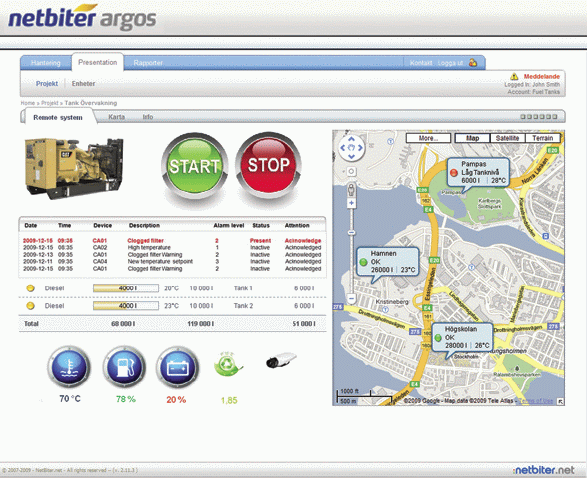 Engineers are always under pressure to reduce costs, improve quality and optimise plant utilisation, but if you can’t measure it, you can’t control it. Stuart Hannah of HMS Industrial Networks explains how the use of cloud computing and the Internet make remote management of your plant and assets a much simpler and more attractive proposition than in the past
Engineers are always under pressure to reduce costs, improve quality and optimise plant utilisation, but if you can’t measure it, you can’t control it. Stuart Hannah of HMS Industrial Networks explains how the use of cloud computing and the Internet make remote management of your plant and assets a much simpler and more attractive proposition than in the past
Improved access to information is the main benefit leading to time saving, improved performance and resource saving. You can see what’s happening 24/7 from any computer or mobile device with an Internet connection. You can instantly receive alarm emails or text messages. You can log historical data and produce graphical trends, automatically backup or restore remote configurations, and track/monitor vehicle locations and record their status in real-time.
How it works
There are three main elements to any cloud based remote monitoring solution (Fig 1). The first is the physical layer that comprises of communication gateway devices that link to your equipment, acquire the data, and communicate it to the remote server. The second is the remote server that collects and stores the data, and the third is secure access to the data through a customised online dashboard.
Communication gateway devices take several forms for ease of connection to the device or equipment being monitored. The connection is generally through serial communications or by using a popular open protocol such as Modbus RTU.
Acquired data is sent to the remote server by the gateway devices at selected logging intervals ranging from real-time to 300 seconds. To communicate with the server, gateways generally use either quad-band GSM/GPRS wireless technologies or Ethernet TCP/IP connections.
GSM (Global Systems for Mobile Communications) is the most widely used technology for mobile communications, whereas GPRS (General Packet Radio Service) is a newer function integrated into GSM that allows for the simultaneous transmission of high speed data across a mobile telephone network. To ensure communication using wireless GPRS is secure, dedicated SIM cards are an option.
Where the communication gateways use Ethernet based connectivity it is normally via wide/local area networks (WAN/LAN) with direct connection to the server via the Internet. Special firewall friendly communications between the remote gateways and the data centre makes it possible to retain the existing broadband security infrastructure at the customer’s site. This gives confidence that the installation is controlled from a security perspective. Communication gateway devices are normally pre-configured and require no programming or IT expertise.
 Data is communicated to and stored on a remote server. In the case of HMS’s Netbiter Argos 3 solution the server is located at one of three data centres and the data backed up at the other two. Information held there can be displayed graphically in the form of customised dashboards, or downloaded into the customer’s businesses management system for analysis and reporting. All server activity is logged at a password holder level.
Data is communicated to and stored on a remote server. In the case of HMS’s Netbiter Argos 3 solution the server is located at one of three data centres and the data backed up at the other two. Information held there can be displayed graphically in the form of customised dashboards, or downloaded into the customer’s businesses management system for analysis and reporting. All server activity is logged at a password holder level.
Information on the server is viewed using a standard web browser. To simplify configuration of the graphical display, standard tools are incorporated into the server including downloadable device templates for establishing communications between the remote plant and the communicating device and auto web pages (dashboards).
User access is controlled by multi-level passwords, which are linked to a user profile to define the level of information or control available. Access is available from any location via the Internet using any suitable PC or mobile device, and because the dashboard is displayed on a standard web browser no special software is required making it convenient for field service staff or managers away from base (Fig 2).
Access to the server information means users can log historical data and produce graphical trends or diagnostics, manage alarms, or automatically backup or restore remote configurations. The functionality exists to configure a SCADA package.
Stand-alone applications
For monitoring and controlling simple stand-alone equipment not required to communicate with the central server, a range of communication gateways with integrated web server functionality are often used. These can be wired or wireless types, and support for an external GPS receiver means that it is also possible to identify the location of the equipment.
This can be particularly useful for fleets of rental machines such as standby generators.
Applications
Anywhere information from remote locations needs to be collected and analysed has the potential to use remote monitoring. It can reduce costs and improve equipment performance by flagging problems at an early stage and optimise maintenance programmes.
Remote management can be integrated into new equipment to provide customers with enhanced functionality and services, or added to existing fixed or moving assets. It helps avoid unnecessary travelling of service personnel to remote locations. It saves time, money and offers businesses the opportunity to provide new services, and it’s simple to implement.

